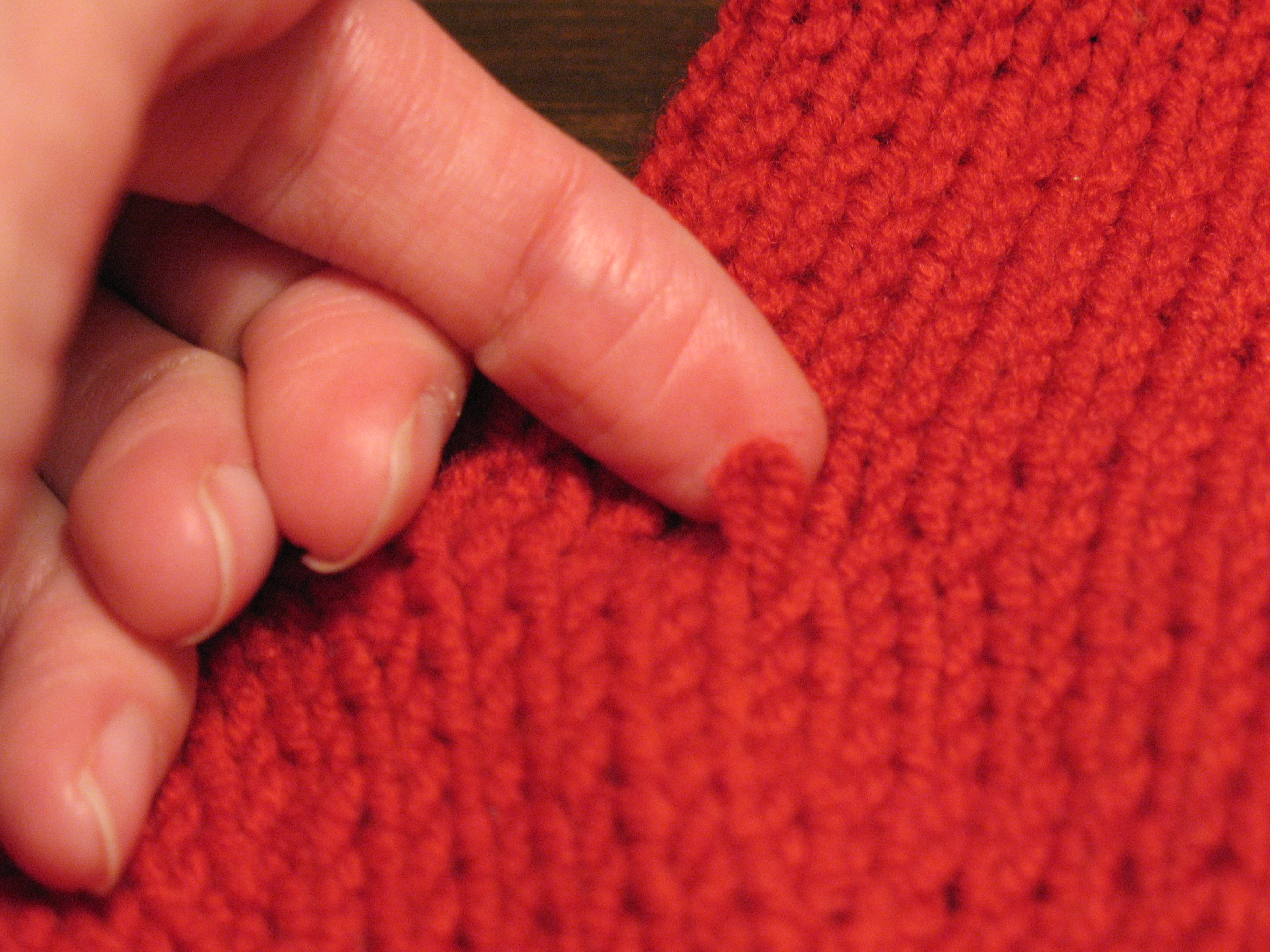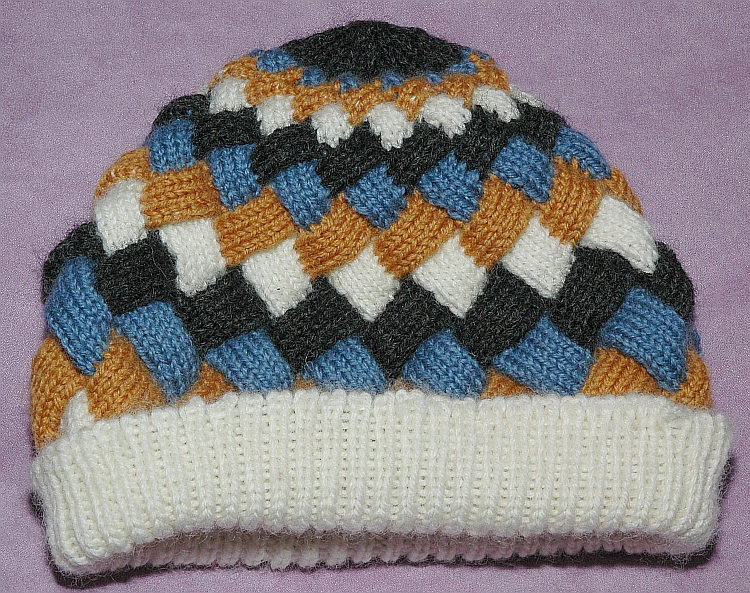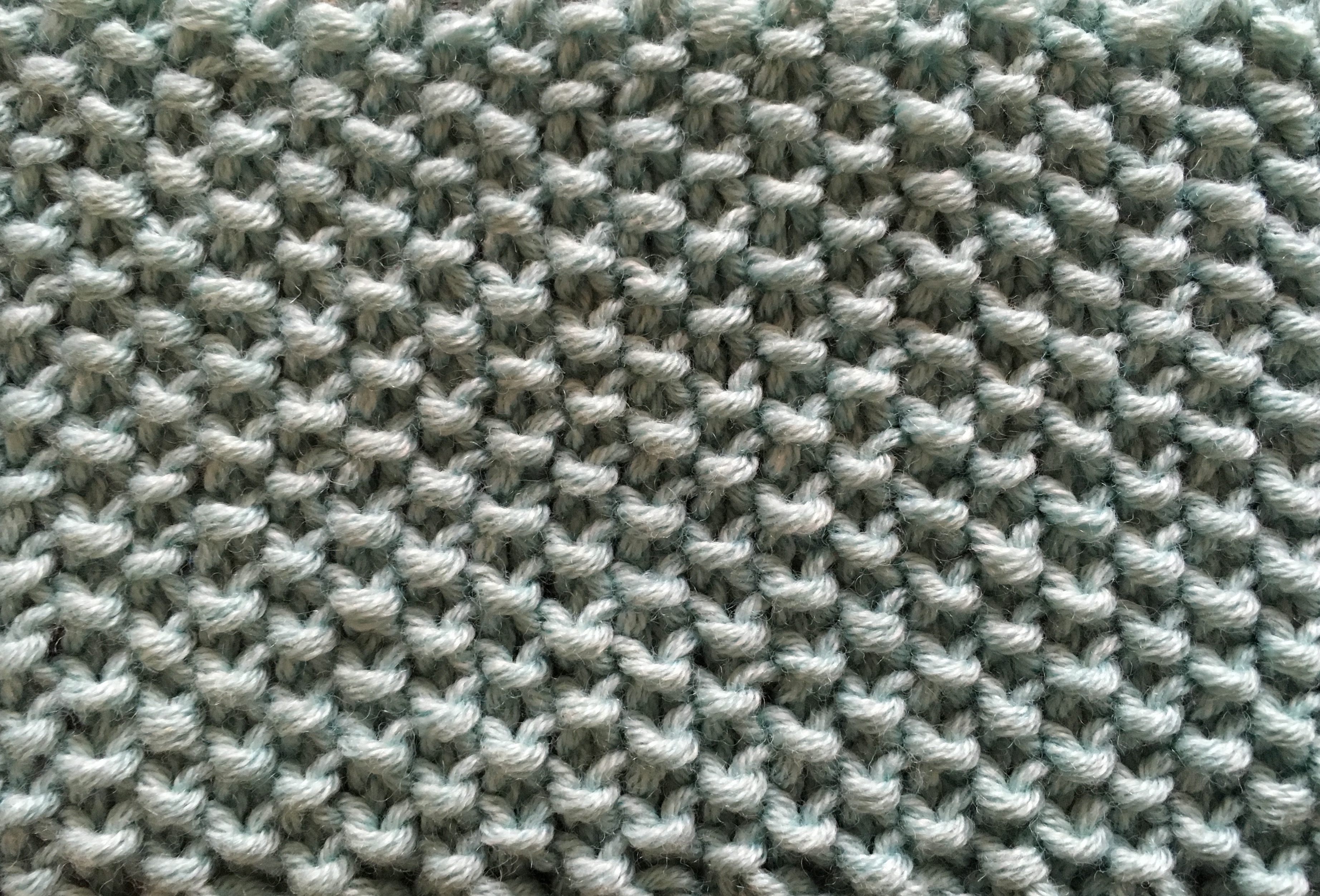|
Basketweave (knitting)
In knitting, a basketweave pattern is characterized by intersecting ribs and welts. In its simplest form, basketweave is composed of a checkerboard pattern of identical rectangles that alternate between stockinette stitch and reverse stockinette stitch. In this form of basketweave, the only variables are the dimensions of the rectangles, i.e., the number of stitches across and number of rows long. If the rectangles are much longer vertically than horizontally, a basketweave may also be called a broken rib pattern. Similarly, if the rectangles are much longer horizontally than vertically, a basketweave may also be called a broken welt pattern. More complicated types of basketweave can be made with allowing the rib and welt widths to vary (i.e., by using rectangles of different sizes), and by allowing some rows or welts to continue uninterrupted. Other variations of basketweave change the stitch patterns that compose the rectangles. Instead of stockinette stitch and its ... [...More Info...] [...Related Items...] OR: [Wikipedia] [Google] [Baidu] |
Knitting Basketweave Stitch (unblocked)
Knitting is a method for production of textile fabrics by interlacing yarn loops with loops of the same or other yarns. It is used to create many types of garments. Knitting may be done by hand or by machine. Knitting creates stitches: loops of yarn in a row; they can be either on straight flat needles or in ''the round'' on needles with (often times plastic) tubes connected to both ends of the needles. There are usually many ''active stitches'' on the knitting needle at one time. Knitted fabric consists of a number of consecutive rows of connected loops that intermesh with the next and previous rows. As each row is formed, each newly created loop is pulled through one or more loops from the prior row and placed on the ''gaining needle so'' that the loops from the prior row can be pulled off the other needle without unraveling. Differences in yarn (varying in fibre type, ''weight'', uniformity and ''twist''), needle size, and stitch type allow for a variety of knitted ... [...More Info...] [...Related Items...] OR: [Wikipedia] [Google] [Baidu] |
Knitting
Knitting is a method for production of textile Knitted fabric, fabrics by interlacing yarn loops with loops of the same or other yarns. It is used to create many types of garments. Knitting may be done Hand knitting, by hand or Knitting machine, by machine. Knitting creates Stitch (textile arts), stitches: loops of yarn in a row; they can be either on straight flat needles or in ''the round'' on needles with (often times plastic) tubes connected to both ends of the Knitting needle, needles. There are usually many ''active stitches'' on the knitting needle at one time. Knitted fabric consists of a number of consecutive rows of connected loops that intermesh with the next and previous rows. As each row is formed, each newly created loop is pulled through one or more loops from the prior row and placed on the ''gaining needle so'' that the loops from the prior row can be pulled off the other needle without unraveling. Differences in yarn (varying in fibre type, Yarn weight, ''w ... [...More Info...] [...Related Items...] OR: [Wikipedia] [Google] [Baidu] |
Ribbing (knitting)
In knitting, ribbing is a pattern in which vertical stripes of stockinette stitch alternate with vertical stripes of reverse stockinette stitch. These two types of stripes may be separated by other stripes in which knit and purl stitches alternate vertically; such plissé stripes add width and depth to ribbing but not more elasticity. The number of knit and purl stripes (wales) are generally equal, although they need not be. When they are equal, the fabric has no tendency to curl, unlike stockinette stitch. Such ribbing looks the same on both sides and is useful for garments such as scarves. Ribbing is notated by (number of knit stitches) × (number of purl stitches). Thus, 1×1 ribbing has one knit stitch, followed by one purl stitch, followed by one knit stitch, and so on. Ribbing has a strong tendency to contract laterally, forming small pleats in which the purl stitches recede and the knit stitches come forward. Thus, ribbing is often used for cuffs, sweater hem ... [...More Info...] [...Related Items...] OR: [Wikipedia] [Google] [Baidu] |
Welting (knitting)
In knitting, welting is the horizontal analog of ribbing; that is, one or more horizontal rows of knit stitches alternating with one or more rows of purl stitches. The simplest welting is garter stitch, in which knit rows alternate with purl rows. If the fabric is produced " in the round", the effect is simply produced by knitting one row, then purling the next. If the fabric is being knit back-and-forth, turned after every row, the effect is produced even more simply by knitting each row—first from the right side, then from the wrong side. Similar to ribbing, a welting pattern can be specified by the number of knit rows followed by the number of purl rows, e.g., 1x1 welting is garter stitch. Many complicated patterns of purely horizontal stripes are possible, which can be worked in yarns of different color, thickness and texture for added visual interest, e.g., wide stripes of red chenille alternating with narrow stripes of black worsted wool. Welts can be decorated with n ... [...More Info...] [...Related Items...] OR: [Wikipedia] [Google] [Baidu] |
Checkerboard
A checkerboard (American English) or chequerboard (British English) is a game board of check (pattern), checkered pattern on which checkers (also known as English draughts) is played. Most commonly, it consists of 64 squares (8×8) of alternating dark and light color, typically green and Buff (colour), buff (official tournaments), black and red (consumer commercial), or black and white (printed diagrams). An 8×8 checkerboard is used to play many other games, including chess, whereby it is known as a chessboard. Other rectangular square-tiled boards are also often called checkerboards. In The Netherlands, however, a ''dambord'' (checker board) has 10 rows and 10 columns for 100 squares in total (see article International draughts). Games and puzzles using checkerboards Martin Gardner featured puzzles based on checkerboards in his November 1962 Mathematical Games column in Scientific American. A square checkerboard with an alternating pattern is used for games including: * Amazons ... [...More Info...] [...Related Items...] OR: [Wikipedia] [Google] [Baidu] |
Rectangle
In Euclidean geometry, Euclidean plane geometry, a rectangle is a Rectilinear polygon, rectilinear convex polygon or a quadrilateral with four right angles. It can also be defined as: an equiangular quadrilateral, since equiangular means that all of its angles are equal (360°/4 = 90°); or a parallelogram containing a right angle. A rectangle with four sides of equal length is a ''square''. The term "wikt:oblong, oblong" is used to refer to a non-square rectangle. A rectangle with Vertex (geometry), vertices ''ABCD'' would be denoted as . The word rectangle comes from the Latin ''rectangulus'', which is a combination of ''rectus'' (as an adjective, right, proper) and ''angulus'' (angle). A #Crossed rectangles, crossed rectangle is a crossed (self-intersecting) quadrilateral which consists of two opposite sides of a rectangle along with the two diagonals (therefore only two sides are parallel). It is a special case of an antiparallelogram, and its angles are not right angles an ... [...More Info...] [...Related Items...] OR: [Wikipedia] [Google] [Baidu] |
Stockinette Stitch
Basic knitted fabrics include stocking stitch, reverse stocking stitch, garter stitch, seed stitch, faggoting, and tricot. In some cases, these fabrics appear differently on the right side (as seen when making the stitch) than on the wrong side (as seen from the other side, when the work is turned). Stockinette/stocking stitch and reverse stockinette stitch Stocking stitch (in US, stockinette stitch) is the most basic knitted fabric; every stitch (as seen from the right side) is a knit stitch. This fabric has also been referred to as Knit or Knitted, Front, Smooth, Jersey, Plain, Vertical and Plain Sweater Fabric. In the round, stocking stitch is produced by knitting every stitch; by contrast, in the flat, stocking stitch is produced by knitting and purling alternate rows. Variations on this fabric can be made by twisting stitches (knitting or purling through the back of each loop on the needle instead of the front) on one or both sides; Barbara Walker calls these "crossed" (o ... [...More Info...] [...Related Items...] OR: [Wikipedia] [Google] [Baidu] |
Cable Knitting
Cable knitting is a style of knitting in which textures of crossing layers are achieved by permuting stitches. For example, given four stitches appearing on the needle in the order ', one might cross the first two (in front of or behind) the next two, so that in subsequent rows those stitches appear in the new order '. Methods The stitches crossing behind are transferred to a small ''cable needle'' for storage while the stitches passing in front (or behind) are knitted. The former stitches are then transferred back to the original needle or knitted from the cable needle itself. Instead of a cable needle, some knitters prefer to use a large safety pin or, for a single stitch, simply hold it in their fingers while knitting the other stitch(es). Cabling is typically done only when working on the right side of the fabric, i.e., every other row. This creates a ''spacer row'', which helps the fabric to relax. Cable knitting usually produces a fabric that is less flexible and more de ... [...More Info...] [...Related Items...] OR: [Wikipedia] [Google] [Baidu] |
Lace Knitting
Lace knitting is a style of knitting characterized by stable holes in the fabric arranged with consideration of aesthetic value. Lace is sometimes considered the pinnacle of knitting, because of its complexity and because woven fabrics cannot easily be made to have holes. Famous examples include the Orenburg shawl and the wedding ring shawl of Shetland knitting, a shawl so fine that it could be drawn through a wedding ring. Shetland knitted lace became extremely popular in Victorian England when Queen Victoria became a Shetland lace enthusiast. Her enthusiasm resulted in her choosing knitted lacework for presents, for example in when the Queen gave a lace shawl as a present to American abolitionist Harriet Tubman. From there, knitting patterns for the shawls were printed in English women's magazines, and they were copied in Iceland with single ply wool. Some consider that "true" knitted lace has pattern stitches on both the right and wrong sides, and that knitting with pattern ... [...More Info...] [...Related Items...] OR: [Wikipedia] [Google] [Baidu] |
Entrelac
Entrelac is a knitting technique used to create a textured diamond pattern. While the result resembles basket-woven strips of knitted fabric, the actual material comprises interconnected squares on two different orientations. Unlike many textured knitting techniques, entrelac allows for colorwork as well. Though single-color entrelac is the norm, it is often used to create colored patterns. The use of variegated yarn with long color repeats for entrelac has become commonplace, since careful use can create distinct squares of color with only one yarn. Entrelac can be knit flat (back-and-forth) or in the round for a cylinder, as for the hat at right. However, unlike typical round knitting, the knitting is turned after a full round of squares so the next set is knitted in the opposite direction. Method Knitting entrelac requires only the knit and purl stitches, an ability to "k2tog" and "p2tog" (knit or purl two stitches together) and to pick up stitches. Entrelac can be done en ... [...More Info...] [...Related Items...] OR: [Wikipedia] [Google] [Baidu] |
Woven
Woven fabric is any textile formed by weaving. Woven fabrics, often created on a loom, are made of many threads woven in a warp and weft. Technically, a woven fabric is any fabric made by interlacing two or more threads at right angles to one another. Woven fabrics can be made of natural fibers, synthetic fibers, or a mixture of both, such as cotton and polyester. Woven fabrics are used for clothing, garments, decorations, furniture, carpets and other uses. Production process Yarn preparation Fibers are spun into yarns and prepared with specific properties tailored for either the warp (longitudinal yarns) or the weft (transverse yarns). Warping The warp yarns are arranged on a beam to prepare for weaving. The warp threads are held taut and parallel, and as such must be strong and durable. Weaving During weaving, the weft yarn passes over and under the warp yarns in various patterns. The primary types of weaves are plain weave, twill weave, and satin weave. These basic ... [...More Info...] [...Related Items...] OR: [Wikipedia] [Google] [Baidu] |






